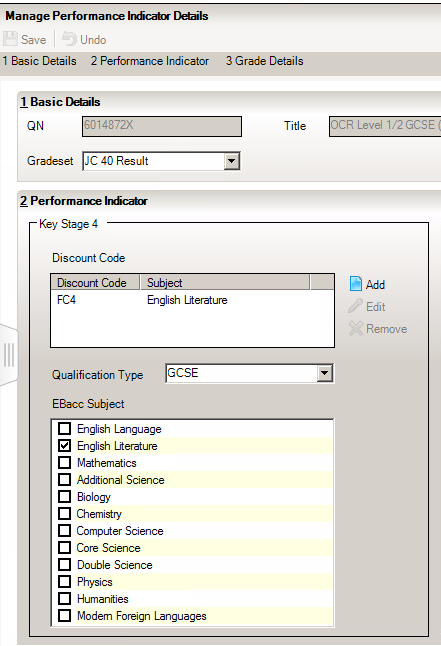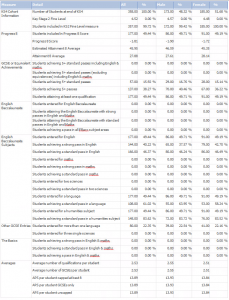Troubleshooting KS4 Performance Indicator Reports
Click below for the sample report output. This is only a guide and will likely not be representative of a school’s true data.
KS4 Cohort Information
Number of Students at end of KS4
Candidates are identified as being at the end of Key Stage 4 if they were on roll at the school and in curriculum year 11 at the time of the Census Day (third Thursday in January) of the January preceding the Summer season.
Key Stage 2 Average Points Score of Cohort
For the candidates identified as belonging to the cohort, the results held in the KS2: Average Point Score Integer Aspect are used. This is populated when the Average Point Score is calculated using the Template ‘KS2 I. Average Point Score Calculator’.
Students included in KS2 APS measure
The number of students in the KS2 APS measure. Progress 8 An additional row has been provided to display details of Students included in Progress 8 Score, and the row previously called Progress 8 has been renamed to Progress 8 Score
- Students included in Progress 8 Score
- Progress 8 Score
- Estimated Attainment 8 Average
- Attainment 8 Average.
GCSE or equivalent Achievements
Students achieving 5+ standard passes including English and Maths
Five qualifying QANs at grade 4 or above including English and grade 4 or above in Maths
Students achieving 5+ standard passes (excluding equivalences) including English and Maths
Five qualifying QANs at grade 4 and above plus grade 4 or above in English and grade 4 or above in Maths (excluding equivalences eg BTEC)
Students achieving 5+ standard passes
Five qualifying QANs at grade 4 or equivalent and above
Students achieving 5+ passes
Five qualifying QANs at grade 4 or equivalent and above
Students achieving at least one qualification
Any single qualifying QAN at grade 1 or equivalent
Attainment 8
The Progress 8 school performance measure is based on a student’s performance across eight subjects and incorporates an additional measure called Attainment 8. The eight subjects are as follows:
- A double weighted mathematics element that contains the point score of the pupil’s EBacc mathematics qualification, (two slots).
- An English element based on the highest point score in a pupil’s EBacc English Language or English Literature qualification. This is double weighted providing a pupil/student has taken both qualifications. This is different from the current situation where only the English Language qualification is counted (assuming that English Literature has been entered). In 2017, a combined English qualification can be included and double weighted, (two slots).
- An element which can include the three highest point scores from any of the following EBacc subjects: Science, Computer Science, History and Geography, and Languages EBacc qualifications. The qualifications can count in any combination and there is no requirement to take qualifications in each of the ‘pillars’ of the EBacc, (three slots).
- The remaining element contains the three highest point scores in any three other subjects, including English Language or Literature (if not counted above), further EBacc 66 qualifications, other GCSEs, or any other approved, high value academic or vocational qualifications, (three slots).
You can check to see if a subject is being included for the EBacc calculations by finding it in Tools > Examinations > Manage Performance Indicators. Find the QAN and open the details, you will see a series of tickboxes under EBacc subject.

If a qualification has been added this year it’s likely that the tick box has not been correctly filled in as by default it is left blank when adding a new QN in the Manage Performance Indicators screen.
English Baccalaureate
Subjects
The English Baccalaureate qualification consists of separate achievements in five subject areas: English, Maths, Science, Languages and Humanities.
English Baccalaureate Rule for 2017:
- To count, either English Language or English Literature must be taken.
- A grade 5 or above must be achieved in English Language or English Literature.
The summary report shows the number and percentage of students entered for and achieving EBacc, the number and percentage of students achieving 9.00-5.00 or A*-C in the subject areas and the number and percentage of students achieving 9.00-1.00 or A*-G in all subject areas.
NOTE: In the English Baccalaureate qualification, a strong pass is considered at grade 5 and above for English and Maths only. A standard pass is considered at grade 4 and above for English and Maths only.
Students entered for English
This is the number of students entered for an English qualification.
Students achieving a strong pass in English
The achievement is the number and percentage of the cohort achieving a strong pass in English (grades 5 and above)
Students entered for Maths
This is the number of students entered for a Maths qualification.
Students achieving a strong pass in Maths
The achievement is the number and percentage of the cohort achieving a strong pass in Maths (grades 5 and above).
NOTE: For English and Maths, the percentage is of the cohort, not the number of entries as it is for the other subject areas.
Students entered for two Sciences
Students entered for two Sciences are those who have entered three out of four single Sciences (Physics, Chemistry, Biology and Computer Science) or Science with Additional Science or Double Science.
Students achieving a standard pass in two Sciences
Students attaining two Sciences are those who have achieved a standard pass in at least two Sciences or in Science and Additional Science or in Double Science (grades C and above).
Students entered for a Language
This is the number of students entered for a qualifying language.
Students achieving a standard pass in a Language
This is the number of students who achieved a standard pass in a qualifying language (grades C and above).
Students entered for a Humanities subject
This is the number of students entered for a qualifying Humanities award.
Students achieving a standard pass in a Humanities subject
This is the number of students who achieved a standard pass in a qualifying Humanities award (grades 4 and above).
Other GCSE Entries
Students entered for more than one language Students entered for multiple languages, e.g. French and Hebrew, etc.
Students entered for three single sciences
Students taking the three single science subjects of Biology, Chemistry and Physics.
The Basics
Students achieving a standard pass in English and Maths
Achieving grade 4 or above in English and Maths.
Students achieving a pass in English and Maths
Achieving grade 1 or above in English and Maths.
Averages
Average number of qualifications per student
This is calculated by dividing the total number of examinations (GCSE and equivalent) taken by all candidates divided by the number of candidates. The total number of examinations has been determined using the equivalence between a GCSE and other qualifications.
The APS calculations are performed after discounting has taken place, so that each subject is included only once.
Average number of GCSEs per student
The total number of GCSEs taken by all students divided by the number of students.
APS per student capped at best 8 (this is a different measure from Progress 8)
The calculation is based on the best 8 scores achieved.
APS per student GCSEs only
GCSE, IGCSE and AS results are included in the measure.
APS per student uncapped
The calculation is based on all scores achieved.
Reviewed 24/5/19
